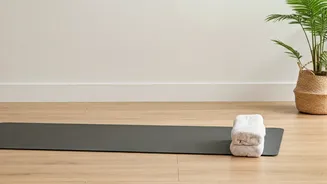Mindful Breathing Techniques
Anxiety often manifests in physical ways, such as rapid heart rate and shallow breathing. One highly effective technique is mindful breathing. This involves
paying close attention to your breath, inhaling deeply, and exhaling slowly. This seemingly simple exercise activates the parasympathetic nervous system, which promotes relaxation. Focus on the sensation of the air entering and leaving your body. Try box breathing: Inhale for a count of four, hold for four, exhale for four, and hold for four. Repeating this a few times can significantly reduce anxiety. Regular practice makes this technique more effective. It allows you to calm down quickly in stressful situations. This is an accessible tool that can be used anywhere, anytime to provide a sense of groundedness and stability. It is about present moment awareness and allowing yourself to observe your breath without judgment, letting go of racing thoughts, and simply existing in the moment. It is very useful in managing panic attacks.
Challenge Negative Thoughts
Anxiety thrives on negative thought patterns. Cognitive restructuring is a technique that helps to identify and challenge these thoughts. When you notice an anxious thought, ask yourself if it's based on facts or assumptions. Often, anxious thoughts are exaggerations or worst-case scenarios. Write down your anxious thoughts. Then, analyze them critically. Ask yourself what evidence supports the thought and what evidence contradicts it. Replace negative thoughts with more balanced and realistic ones. For example, if you think, "I'm going to fail," reframe it as, "I've prepared, and I'll do my best." This process takes practice, but it's a powerful way to weaken the grip of anxiety. The aim is to reshape your thinking, reducing the intensity of anxious feelings. By challenging these negative thought patterns, it’s possible to reduce anxiety and promote a more positive outlook.
Embrace Gentle Exercise
Physical activity plays a significant role in managing anxiety. Gentle exercise, such as walking, yoga, or swimming, can be particularly beneficial. Exercise releases endorphins, which have mood-boosting effects. It can also help distract your mind from anxious thoughts. Aim for at least 30 minutes of moderate-intensity exercise most days of the week. Find an activity you enjoy, making it easier to stick to your routine. Regular exercise improves sleep quality, which is often disrupted by anxiety. Even a short walk in nature can make a difference. Prioritize activities that calm your mind and body. This could include stretching, deep breathing exercises, or mindful movement practices. Making exercise a part of your daily routine not only improves physical health but also provides a powerful tool to manage and reduce anxiety, promoting a sense of well-being and control.
Set Realistic Expectations
Anxiety can be triggered by unrealistic expectations. Setting achievable goals and accepting that perfection is unattainable can significantly reduce anxiety. Break down large tasks into smaller, manageable steps. This makes goals feel less overwhelming. Focus on progress, not perfection. Celebrate your achievements, no matter how small. Recognize that setbacks are a normal part of life. Learn from them without excessive self-criticism. Practice self-compassion. Treat yourself with the same kindness and understanding you would offer a friend. Remind yourself that you're doing your best. By adjusting your expectations and embracing imperfections, you'll reduce the pressure and promote a more balanced and less anxious outlook. This shift in perspective can help you manage stress and increase your overall well-being, paving the way for inner peace.
Limit Information Overload
In today's fast-paced world, information overload is a significant contributor to anxiety. Constant exposure to news, social media, and other sources can be overwhelming and lead to increased stress and anxiety levels. Be mindful of your media consumption. Set limits on the time you spend on news and social media. Unfollow or mute accounts that trigger negative emotions. Create periods of digital disconnection throughout the day. This could include turning off notifications or taking breaks from your devices. Engage in activities that provide mental rest. Spending time in nature, reading a book, or pursuing a hobby can help you relax and recharge. By controlling your exposure to information, you create space for mental clarity and reduce the potential for anxiety triggers. This is an important step to improve your overall mental health.











